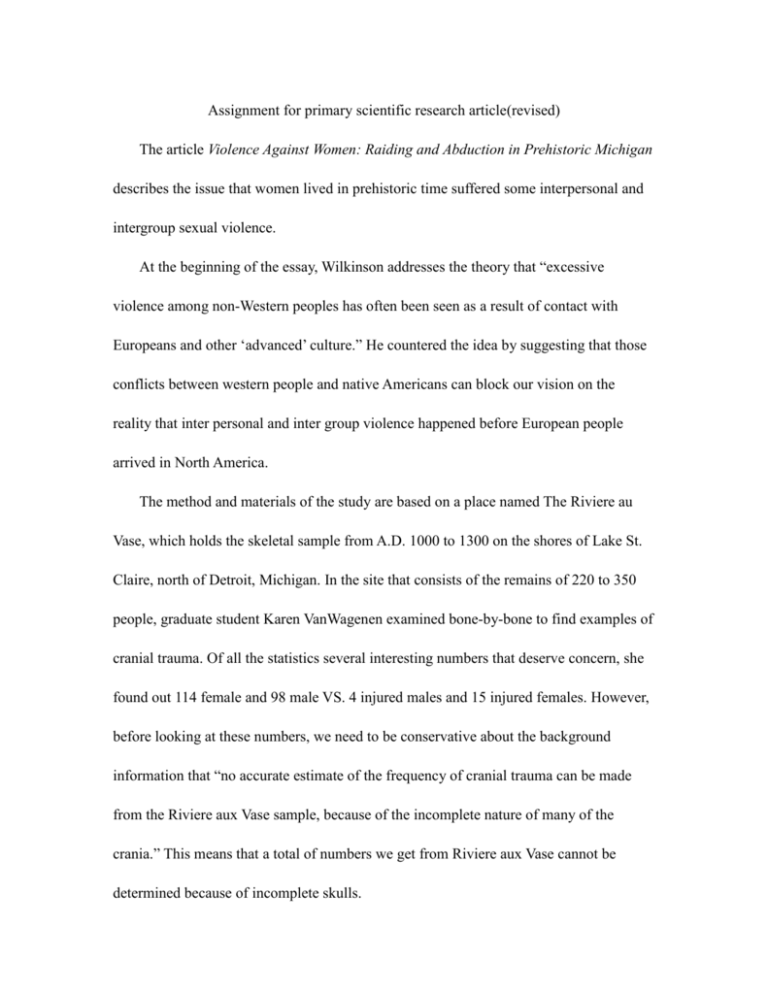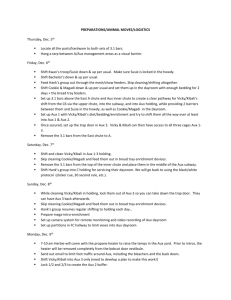Assignment for primary scientific research article
advertisement

Assignment for primary scientific research article(revised) The article Violence Against Women: Raiding and Abduction in Prehistoric Michigan describes the issue that women lived in prehistoric time suffered some interpersonal and intergroup sexual violence. At the beginning of the essay, Wilkinson addresses the theory that “excessive violence among non-Western peoples has often been seen as a result of contact with Europeans and other ‘advanced’ culture.” He countered the idea by suggesting that those conflicts between western people and native Americans can block our vision on the reality that inter personal and inter group violence happened before European people arrived in North America. The method and materials of the study are based on a place named The Riviere au Vase, which holds the skeletal sample from A.D. 1000 to 1300 on the shores of Lake St. Claire, north of Detroit, Michigan. In the site that consists of the remains of 220 to 350 people, graduate student Karen VanWagenen examined bone-by-bone to find examples of cranial trauma. Of all the statistics several interesting numbers that deserve concern, she found out 114 female and 98 male VS. 4 injured males and 15 injured females. However, before looking at these numbers, we need to be conservative about the background information that “no accurate estimate of the frequency of cranial trauma can be made from the Riviere aux Vase sample, because of the incomplete nature of many of the crania.” This means that a total of numbers we get from Riviere aux Vase cannot be determined because of incomplete skulls. The method of this study draws from these two areas, a. age and sex, b. location and severity of injuries. In the sex-determined method, due to the fact that most skulls do not have accompanied pelves, forensic techniques are replaced by skull morphology, dental attrition and ectocranial suture closure. The aging methods are less precise than desired. The conclusion of sex and age methods is that there are much more injured females (6) aging from 16 to 40 than males (1) aging from 16 to 40. Also, younger females aging from 21 to 25(3) have higher injured frequency than old females aging from 31 to 35 or aging from 36 to 40 (1). There is another evidence that women who are older than 45 years old have “mild” injuries with only one exception. This might be the result of osteoporosis. The location and severity of injuries method reveals that the frontal bone has twice the resistance strength than the parietals. In the Riviere aux Vase site where there is higher frequency on frontal fractures and aggressive attack might explain these injuries. Another proof is the postcranial factures. Quiet a few postcranial injuries as well as large area of injures on women indicate that attack with blunt weapon was directed purposely at women. Using the methods and materials, the author put the Riviere aux Vase into a broader framework that these injures could by caused by spousal abuse, intra-sex competition, and raiding and abduction. By comparing skulls of Riviere aux Vase to other similar samples from other sites among Iroquois, the Western Abenaki, the Miami…Wilkinson concludes that abduction is the main reason for injuries in women. However, this raises two concerns about abduction, whether one group or several groups utilize this site and whether affiliation of women is natal or external. We don’t know. My critique about this method is based on three aspects. First, all the material is solely based on one site Riviere aux Vase, which represents only a small area in North America. In the history research, one proof or sample is not enough. Two or more proofs are required to make a conclusion. Next, most skeletal samples disappeared in the process of decomposition. Thus the meaning of the remains is limited. Those skeletal samples might dramatically change this theory. Third, not all of the skeletal examples can be used in statistics because of the incomplete nature of crania. So, there is a great amount of possibility that this site is over “evaluated” in the experiment. From a few skulls to the conclusion that women in prehistory time got injured because of abduction, I also doubt the credibility of relating evidence to conclusion. First, if the fractures on these women were caused by abduction, it would be unreasonable to explain the existence of very large fractures. Usually, abduction is accompanied with a threat but not heavy injuries. Nobody wants to abduct a patient. Secondly, we are not sure whether one group or several groups utilized this site. If several groups used this site as cemetery, there might be different reasons for the fractures. So, I think an alternative interpretation of the data could be a battle among tribes. Those women were defending themselves and got injured in a battle. Because they were weaker than men, they were more likely to be injured. This explains the fact that they have more injures from the front of head and that they were buried after injury. How I revise this essay. Deb suggests me that I should switch the sequence between summery and my critique and I accept Deb’s advice. In the last two essays, I combine my critique to methods and the reasons that the author relates his evidence and conclusion together. I also correct some errors.






